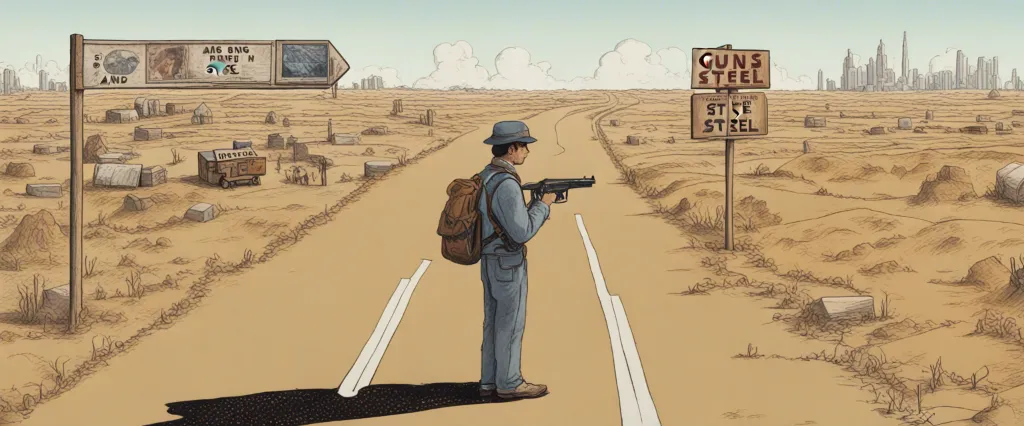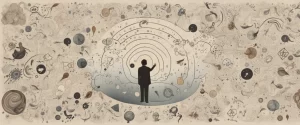
Books have long served as windows into the past, providing us with insights, knowledge, and perspectives we may never have otherwise encountered. Within the realm of historical literature, there are countless works that depict significant events, ideas, and cultural shifts. Two such books, Guns, Germs, and Steel by Jared Diamond and 1453 by Roger Crowley, present captivating narratives that shed light on distinct periods with global ramifications.
Guns, Germs, and Steel, published in 1997, explores the question of why certain civilizations have dominated others throughout history. Jared Diamond’s groundbreaking work traverses continents and millennia to analyze the underlying factors that shaped the course of human history. In contrast, 1453, published in 2005, delves into the dramatic fall of Constantinople and the subsequent rise of the Ottoman Empire. Roger Crowley examines the events surrounding one of history’s most crucial turning points, whose echoes continue to reverberate even today.
While these two books discuss seemingly disparate topics, they both offer profound historical insights and aim to unravel some of the mysteries that have shaped our world. Guns, Germs, and Steel focuses on the broader scope of human development, interrogating the factors that contributed to the dominance of certain civilizations over others. On the other hand, 1453 delves into an intricately specific historical event that irrevocably altered the trajectory of European and Middle Eastern history.
Though divergent in their subjects, a comparative study of these two books presents an opportunity to explore the broader themes that connect them. Both Diamond and Crowley endeavor to unearth hidden patterns and shed light on the consequences of such historical moments. Whether through an in-depth analysis of civilizations or an exploration of a singular event, the authors endeavor to provide readers with a fresh perspective on our shared past.
This comparative study aims to dissect and examine the unique approaches taken by Jared Diamond and Roger Crowley in presenting historical narratives. By analyzing their research, methodologies, and storytelling techniques, we hope to unfold the common threads that bind these works together while appreciating their distinctive contributions to the historical literature.
Through this investigation, the study endeavors to unveil the intricate complexities of human history and the numerous forces that have shaped our world. In juxtaposing the scope of Guns, Germs, and Steel with the focused exploration of 1453, we seek to shed light on the broader historical implications as well as the significance of individual historical events.
As we embark on this comparative study, it is our hope that the analysis of these two influential works will not only deepen our understanding of the past but also provide valuable insights into our present and future. By exploring the factors that determined the fates of entire civilizations and the impact of pivotal moments in history, we can discern patterns, uncover hidden influences, and ultimately broaden our perspectives.
In the pages that follow, we will delve into the research, analysis, and narratives of Guns, Germs, and Steel and 1453, aiming to reveal the shared themes, contrasting methodologies, and the historical legacies that linger within each book’s pages.
Brief Summary of Two Books
Guns Germs and Steel by Jared Diamond
“Guns, Germs, and Steel” by Jared Diamond explores the factors that have led to the unequal distribution of power and resources among different societies around the world. Diamond argues that the key determinants are environmental factors such as geography, availability of domesticable plants and animals, and the development and spread of agriculture.
The book starts by examining the origins of human societies and how they transitioned from hunter-gatherer lifestyles to settled agriculture. Diamond presents evidence that certain areas (like the Fertile Crescent in the Middle East) had a more favorable environment for the development of domestication compared to others (like Australia). This allowed societies in these areas to achieve food surpluses, leading to population growth, specialization, and the emergence of complex social and political structures.
Diamond then delves into the impact of geography on the spread of agriculture and subsequent technological advancements. He argues that societies that had access to easily domesticable crops or animals (such as wheat or horses) were able to develop faster and conquer neighboring regions, leading to the rise of powerful empires.
The book also explores the effects of disease on human populations. Diamond highlights how certain regions were more susceptible to the domestication and transmission of diseases, as seen in the devastating impact of European diseases on Native American populations upon contact. This biological advantage played a significant role in colonization and the further spread of European domination.
In summary, “Guns, Germs, and Steel” presents a comprehensive theory about why certain societies became more advanced and dominant than others. By examining environmental factors, societal development, and the impact of disease, Diamond offers a new perspective on the course of human history and challenges common narratives of cultural superiority.
1453 by Roger Crowley
“1453: The Holy War for Constantinople and the Clash of Islam and the West” by Roger Crowley is a historical account of the pivotal year in which the Byzantine capital, Constantinople, fell to the Ottoman Empire. The book delves into the political, religious, and military dynamics that led to this significant event, marking the end of the Byzantine Empire and the beginning of a new era.
Crowley provides a comprehensive overview of the geopolitical landscape leading up to the year 1453. He explores the governing structures, cultural richness, and religious significance of Constantinople, which had for centuries acted as a bridge between the Christian West and the Islamic East. The book also highlights the rise of the powerful Ottoman Empire under Sultan Mehmed II and its gradual expansion, with Constantinople being its ultimate target.
The siege of Constantinople forms the central narrative of the book. Crowley meticulously details the military strategies, equipment, and tactics employed by both sides during the siege. He provides vivid descriptions of the intense warfare, the construction of massive cannons by the Ottomans, and the desperation of the Byzantines as they fought to defend their city.
“1453” also delves into the personalities and motivations of key figures involved in the conflict, such as Emperor Constantine XI and Sultan Mehmed II. Crowley explores the religious tensions between Christendom and Islam, examining how these factors influenced the actions of the leaders and the soldiers on both sides.
The book concludes with the fall of Constantinople on May 29, 1453, and the subsequent consequences for both the victors and the defeated. Crowley reflects on the profound impact of this event on world history, noting how it transformed the balance of power between East and West, as well as the wider clash of civilizations between Christianity and Islam.
Overall, “1453” presents a detailed and engaging account of the remarkable siege of Constantinople, providing readers with a deeper understanding of the historical, religious, and cultural forces at play during this pivotal period.
Comparison between Two Books

Similarities in Global Landscape
In both Guns, Germs, and Steel by Jared Diamond and 1453 by Roger Crowley, the authors discuss how historical events shaped the global landscape. Despite focusing on different time periods and regions, there are striking similarities in their analysis of the factors that influenced the development of societies and the impact on the global landscape.
1. Geographic Determinism: Both books emphasize the significance of geography in shaping the course of history. Diamond highlights the importance of natural resources, climate, and topography in enabling or hindering the rise of civilizations. Similarly, Crowley explores how the geographical advantage of Constantinople played a vital role in its ability to remain a powerful city for centuries.
2. Technologies and Innovations: Diamond and Crowley both recognize the pivotal role played by technological advancements in shaping civilizations. Diamond examines the development of agriculture, animal domestication, and the spread of metallurgy as crucial factors contributing to the growth of certain societies. Similarly, Crowley delves into the military technologies, such as artillery, that were instrumental in the Ottoman conquest of Constantinople.
3. Interconnectedness: Both authors discuss the global interactions and exchanges that took place throughout history. Diamond examines the diffusion of crops, diseases, and ideas across different regions, creating interconnected networks. Similarly, Crowley explores the vibrant trade routes and cultural exchange that converged in Constantinople, making it a cosmopolitan hub.
4. Conflict and Conquest: Both books acknowledge the role of conflict and conquest in shaping the global landscape. Diamond analyzes how the domestication of large mammals and the availability of germs carried by humans led to the dominance of certain groups over others. Likewise, Crowley chronicles the decisive Ottoman conquest of Constantinople in 1453, leading to significant geopolitical alterations in Europe and the Middle East.
5. Social and Cultural Factors: Both authors recognize that social and cultural factors also played a significant role in shaping the global landscape. Diamond delves into the impact of societal organization, political structures, and belief systems on the success or failure of civilizations. Similarly, Crowley explores the diverse ethnic and religious tapestry of Constantinople and the resulting interplay between different cultures.
In conclusion, both Guns, Germs, and Steel by Jared Diamond and 1453 by Roger Crowley analyze how historical events influenced the global landscape. They both emphasize the importance of geography, the role of technological advancements, the interconnectedness of societies, the impact of conflict, and the significance of social and cultural factors. By paralleling these works, one can develop a more comprehensive understanding of the factors that have molded the world we live in today.
Divergences in Global Landscape
Guns, Germs, and Steel by Jared Diamond and 1453 by Roger Crowley are both influential books that explore the global landscape from different perspectives and time periods. While both books discuss historical events and their impact on the world, they differ in scope and focus.
In Guns, Germs, and Steel, Jared Diamond seeks to explain the domination of certain civilizations over others by analyzing the role of geography, technology, and biology. He examines the unequal distribution of resources and the development of agriculture, which led to the rise of complex societies in some regions. Diamond argues that certain regions, like Eurasia, were more conducive to the development of advanced civilizations due to favorable geographical and biological factors. He challenges the notion of inherent superiority of certain cultures and argues that environmental factors played a crucial role in shaping the course of history.
On the other hand, Roger Crowley’s 1453 focuses specifically on the fall of Constantinople, the pivotal event that marked the end of the Byzantine Empire and the rise of the Ottoman Empire. Crowley delves into this historical turning point, providing a detailed account of the lead-up to the siege and the final battle. He examines the military strategies, political alliances, and individuals who played a significant role in this event. Unlike Diamond’s book, 1453 zooms in on a specific time period and event, offering a more focused analysis of the global impact resulting from the fall of Constantinople.
In terms of divergence in the global landscape, Guns, Germs, and Steel covers a vast expanse of human history, spanning thousands of years and exploring the development of civilizations on different continents. Its scope is broader and more comprehensive, encompassing various regions and their interactions. Diamond’s book highlights the long-term effects of geography, agriculture, and technology on different societies. In contrast, 1453 zooms in on a specific moment in time, examining the geopolitical consequences of the fall of Constantinople. Crowley’s book focuses on the regional impact and the shift in power dynamics within the Eastern Mediterranean and the Balkans.
In summary, while both Guns, Germs, and Steel by Jared Diamond and 1453 by Roger Crowley offer valuable insights into the global landscape, they differ in terms of their focus and scope. Diamond’s book explores the long-term influences of geography, agriculture, and technology on civilizations across continents, while Crowley’s book delves into the specific historical event of the fall of Constantinople and its regional repercussions.

Conclusion
Both “Guns, Germs, and Steel” by Jared Diamond and “1453” by Roger Crowley are highly regarded and influential works in their respective fields.
“Guns, Germs, and Steel” is a Pulitzer Prize-winning book that explores the role of geography, biology, and societal development in shaping human history. Diamond examines why some civilizations have thrived while others have declined, and he argues that geographic and environmental factors have played a significant role in these outcomes. This book provides a comprehensive and thought-provoking perspective on the forces that have shaped the world we live in today.
On the other hand, “1453” focuses specifically on the fall of Constantinople to the Ottoman Empire in that year. Roger Crowley provides a gripping account of the events leading up to the siege and the subsequent conquest. This book delves into the specific historical events surrounding the fall of Constantinople and offers a detailed understanding of the political, military, and cultural context of the time.
Both books offer unique insights into different aspects of history. If you are interested in understanding the broader factors influencing the course of human history and civilizations, “Guns, Germs, and Steel” would be a more fitting choice. However, if you are specifically interested in the fall of Constantinople and the captivating narrative surrounding it, “1453” would be the preferred option.
Ultimately, the choice between the two books depends on your personal interests and what aspect of history you are most curious about.


